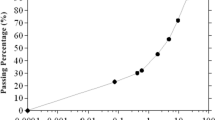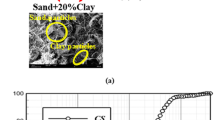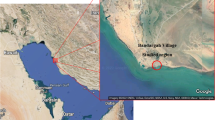Abstract
There has been an inclination towards using sustainable and environmentally friendly soil stabilizers to reduce the carbon footprint resulting from the production process of ordinary Portland cement. Polymers soil stabilizers have proven to be effective towards improving the strength of marginal soil. Despite this significant improvement, certain polymers are susceptible to the action of wetting, which results in a loss in strength. Thus, this study aims to investigate the mechanical properties and the durability of polymer-modified dune sand. Poly(vinylidene fluoride) (PVDF) polymer was used as the soil stabilizer in varying concentrations of 3, 6, 9, and 12%. The efficacy of the polymer was evaluated by conducting unconfined compressive strength (UCS) and direct shear tests. The durability test was divided into two categories: constant soaking and cyclic wetting–drying. Changes in the morphology of the sand as a result of polymer inclusion were investigated by scanning electron microscopy (SEM). The result showed that the UCS, shear strength and cohesion increased with polymer concentrations, while the frictional angle did not change significantly. The polymer-modified sand specimens lost about 60–75% of their strength after being submerged in water for 7–21 days. However, there was no reduction in strength for specimens subjected to 3 and 7 wetting–drying cycles. The action of drying following each wetting cycle reactivated the bond properties of the PVDF polymer. SEM confirmed the presence of the polymer links between the sand grains after constantly soaking. The loss of strength, in this case, can be linked to the presence of water molecules within the structure of the polymer-sand matrix. In conclusion, the PVDF polymer exhibits potential as an effective stabilizer against water susceptibility and elevated temperature.










Similar content being viewed by others
Data Availability
The data collected and analyzed during this study are available upon request from the corresponding author.
References
Mohamed, S.W.A.: Stabilization of Desert Sand Using Water-borne Polymers. Ph.D. thesis, United Arab Emirates University (2004)
Makusa, G.P.: Soil Stabilization Methods and Materials. Luleå University of Technology (2012)
Soldo, A.: Biopolymers for enhancing the engineering properties of soil (2020)
Liu, J.; Bai, Y.; Song, Z.; Lu, Y.; Qian, W.; Kanungo, D.P.: Evaluation of strength properties of sand modified with organic polymers. Polymers 10(3), 287 (2018)
Nicholson, P.G.: Admixture soil improvement. Soil Improv. Ground Modif. Methods 231–288 (2015)
Prusinski, J.R.; Bhattacharja, S.: Effectiveness of Portland cement and lime in stabilizing clay soils. Transp. Res. Rec. 1652(1), 215–227 (1999)
Mohammed, A.A.; Nahazanan, H.; Nasir, N.A.M.; Huseien, G.F.; Saad, A.H.: Calcium-based binders in concrete or soil stabilization: challenges, problems, and calcined clay as partial replacement to produce low-carbon cement. Materials 16(5), 2020 (2023)
Jawad, I.T.; Taha, M.R.; Majeed, Z.H.; Khan, T.A.: Soil stabilization using lime: advantages, disadvantages and proposing a potential alternative. Res. J. Appl. Sci. Eng. Technol. 8(4), 510–520 (2014)
Almajed, A.; Lemboye, K.; Moghal, A.A.B.: A critical review on the feasibility of synthetic polymers inclusion in enhancing the geotechnical behavior of soils. Polymers 14(22), 5004 (2022)
Al-Khanbashi, A.; Abdalla, S.W.: Evaluation of three waterborne polymers as stabilizers for sandy soil. Geotech. Geol. Eng. 24(6), 1603–1625 (2006)
Almajed, A.; Abbas, H.; Almusallam, T.; Al-Salloum, Y.: Stabilization of sand using energy efficient materials under normal and extreme hot weathers. J. Clean. Prod. 285, 124914 (2021)
Arasan, S.; Işik, F.; Akbulut, R.K.; Zaimoğlu, A.S.; Nasirpur, O.: Rapid stabilization of sands with deep mixing method using polyester. Period. Polytech. Civ. Eng. 59(3), 405–411 (2015)
Bai, Y., et al.: Unconfined compressive properties of composite sand stabilized with organic polymers and natural fibers. Polymers 11(10), 1576 (2019)
Georgees, R.N.; Hassan, R.A.; Evans, R.P.: A potential use of a hydrophilic polymeric material to enhance durability properties of pavement materials. Constr. Build. Mater. 148, 686–695 (2017)
Liu, J., et al.: Study on the brittleness characteristics of sand reinforced with polypropylene fiber and polyurethane organic polymer. Fibers Polym. 20(3), 620–632 (2019)
Liu, J., et al.: Tensile behavior of polyurethane organic polymer and polypropylene fiber-reinforced sand. Polymers 10(5), 499 (2018)
Liu, J., et al.: Improvement effect of water-based organic polymer on the strength properties of fiber glass reinforced sand. Polymers 10(8), 836 (2018)
Liu, J.; Feng, Q.; Wang, Y.; Bai, Y.; Wei, J.; Song, Z.: The effect of polymer-fiber stabilization on the unconfined compressive strength and shear strength of sand. Adv. Mater. Sci. Eng. 2017 (2017)
Rezaeimalek, S.; Huang, J.; Bin-Shafique, S.: Performance evaluation for polymer-stabilized soils. Transp. Res. Rec. 2657(1), 58–66 (2017)
Zandieh, A.R.; Yasrobi, S.S.: Retracted article: study of factors affecting the compressive strength of sandy soil stabilized with polymer. Geotech. Geol. Eng. 28(2), 139–145 (2010)
Liu, J., et al.: Topsoil reinforcement of sandy slope for preventing erosion using water-based polyurethane soil stabilizer. Eng. Geol. 252, 125–135 (2019)
Liu, J. et al.: Laboratory tests on effectiveness of environment-friendly organic polymer on physical properties of sand. Int. J. Polym. Sci. 2018 (2018)
Liu, J.; Qi, X.; Zhang, D.; Feng, Q.; Wang, Y.; Kanungo, D.P.: Study on the permeability characteristics of polyurethane soil stabilizer reinforced sand. Adv. Mater. Sci. Eng. 2017 (2017)
Bakhshi, M.M.; Ayati, B.; Ganjidoust, H.: Soil stabilization by nano polymer polylattice (case study: Hossein Abad area of Qom Province). Amirkabir J. Civ. Eng. 52(12), 18–18 (2019)
Ding, X.; Xu, G.; Zhou, W.; Kuruppu, M.: Effect of synthetic and natural polymers on reducing bauxite residue dust pollution. Environ. Technol. 41(5), 556–565 (2020)
Movahedan, M.; Abbasi, N.; Keramati, M.: Wind erosion control of soils using polymeric materials. Eurasian J. Soil Sci. 1(2), 81–86 (2012)
Wang, Y., et al.: Investigation into mechanical behavior of air-hardening organic polymer-stabilized silty sand. J. Mater. Civ. Eng. 34(11), 04022305 (2022)
Park, S.-S.; Park, J.-W.; Yoon, K.-B.; Park, I.S.; Woo, S.-W.; Lee, D.-E.: Evaluation of compressive strength and thermal conductivity of sand stabilized with epoxy emulsion and polymer solution. Polymers 14(10), 1964 (2022)
Eisenmenger, W.; Schmidt, H.; Dehlen, B.: Space charge and dipoles in polyvinylidenefluoride. Braz. J. Phys. 29, 295–305 (1999)
Akovalı, G.: Polymers in Construction. iSmithers Rapra Publishing (2005)
Balli, B.; Şavk, A.; Şen, F.: Graphene and polymer composites for supercapacitor applications. In: Nanocarbon and its Composites. Elsevier, pp. 123–151 (2019). https://doi.org/10.1016/B978-0-08-102509-3.00005-5
Mokhtari, F.; Latifi, M.; Shamshirsaz, M.: Electrospinning/electrospray of polyvinylidene fluoride (PVDF): piezoelectric nanofibers. J. Text. Inst. 107(8), 1037–1055 (2016)
Saxena, P.; Shukla, P.: A comprehensive review on fundamental properties and applications of poly(vinylidene fluoride) (PVDF). Adv. Compos. Hybrid Mater. 4, 1–19 (2021)
ASTM D2166-06: Standard test method for unconfined compressive strength of cohesive soil. ASTM International, West Conshohocken (2007)
ASTM D3080: Standard test method for direct shear test of soils under consolidated drained conditions. ASTM International, West Conshohocken (2004)
ASTM D559: Standard test methods for wetting and drying compacted soil-cement mixtures. ASTM International, West Conshohocken (2015)
Park, H.K.; Lee, H.; Vimonsatit, V.: Investigation of Pindan soil modified with polymer stablisers for road pavement. J. Infrastruct. Preserv. Resil. 1(1), 1–10 (2020)
Liu, J.; Feng; Q.; Wang, Y.; Zhang, D.; Wei, J.; Kanungo, D.P.: Experimental study on unconfined compressive strength of organic polymer reinforced sand. Int. J. Polym. Sci. 2018
Rezaeimalek, S.; Nasouri, A.; Huang, J.; Bin-Shafique, S.; Gilazghi, S.T.: Comparison of short-term and long-term performances for polymer-stabilized sand and clay. J. Traffic Transp. Eng. Engl. Ed. 4(2), 145–155 (2017)
Fu, H., et al.: Hydrophobic polymeric additives toward a long-term robust carbonaceous mudstone slope. Polymers 13(5), 802 (2021)
ASTM D4609: American Society for Testing and Materials. Committee...—Google Scholar (2008). https://scholar.google.com/scholar_lookup?title=Standard%20Guide%20for%20evaluating%20Effectiveness%20of%20Admixtures%20for%20Soil%20Stabilization&author=ASTM%20D4609&publication_year=2008. Accessed 9 Dec 2021
Liu, J., et al.: An experimental study on the shear behaviors of polymer-sand composite materials after immersion. Polymers 10(8), 924 (2018)
Ozhan, H.O.: Measuring shear strength parameters of polymer-added bentonite-sand mixtures in laboratory experiments. In: E3S Web of Conferences, p. 11014. EDP Sciences (2019).
Naeini, S.A.; Ghorbanali, M.: Effect of wet and dry conditions on strength of silty sand soils stabilized with epoxy resin polymer. J. Appl. Sci. 10(22), 2839–2846 (2010)
Marshall, J.E., et al.: On the solubility and stability of polyvinylidene fluoride. Polymers 13(9), 1354 (2021)
de Jesus Silva, A.J.; Contreras, M.M.; Nascimento, C.R.; da Costa, M.F.: Kinetics of thermal degradation and lifetime study of poly(vinylidene fluoride) (PVDF) subjected to bioethanol fuel accelerated aging. Heliyon 6(7), e04573 (2020)
Hatibu, N.; Hettiaratchi, D.R.P.: The transition from ductile flow to brittle failure in unsaturated soils. J. Agric. Eng. Res. 54(4), 319–328 (1993)
Acknowledgements
The authors gratefully acknowledge the Researchers Supporting Project Number RSP-2023/279, King Saud University, Riyadh, Saudi Arabia, for their financial support for the research work reported in this article.
Author information
Authors and Affiliations
Contributions
Conceptualization: KL, AA; Methodology; Formal analysis and investigation; and Writing—initial draft preparation: KL; Writing—review and editing: AA; Funding acquisition: AA; Resources: KL, AA; Supervision: AA.
Corresponding author
Ethics declarations
Conflict of interest
The authors state that no known competing financial interests or personal relationships could appear to have influenced the work described in this study.
Rights and permissions
Springer Nature or its licensor (e.g. a society or other partner) holds exclusive rights to this article under a publishing agreement with the author(s) or other rightsholder(s); author self-archiving of the accepted manuscript version of this article is solely governed by the terms of such publishing agreement and applicable law.
About this article
Cite this article
Lemboye, K., Almajed, A. Experimental Study on the Mechanical Properties and Durability of Sand Using a Semicrystalline Hydrophobic Fluoropolymer. Arab J Sci Eng 48, 13707–13717 (2023). https://doi.org/10.1007/s13369-023-07942-2
Received:
Accepted:
Published:
Issue Date:
DOI: https://doi.org/10.1007/s13369-023-07942-2




